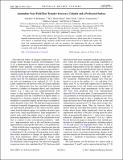| dc.contributor.author | Rodriguez-Wong, Alejandro | |
| dc.contributor.author | Reid, M. T. Homer | |
| dc.contributor.author | Varela, Jaime | |
| dc.contributor.author | Capasso, Federico | |
| dc.contributor.author | Joannopoulos, John | |
| dc.contributor.author | Johnson, Steven G | |
| dc.date.accessioned | 2013-01-30T16:51:53Z | |
| dc.date.available | 2013-01-30T16:51:53Z | |
| dc.date.issued | 2013-01 | |
| dc.date.submitted | 2012-07 | |
| dc.identifier.issn | 0031-9007 | |
| dc.identifier.issn | 1079-7114 | |
| dc.identifier.uri | http://hdl.handle.net/1721.1/76661 | |
| dc.description.abstract | We predict that the near-field radiative heat-transfer rate between a cylinder and a perforated surface depends nonmonotonically on their separation. This anomalous behavior, which arises due to evanescent-wave effects, is explained using a heuristic model based on the interaction of a dipole with a plate. We show that nonmonotonicity depends not only on geometry and temperature but also on material dispersion—for micron and submicron objects, nonmonotonicity is present in polar dielectrics but absent in metals with small skin depths. | en_US |
| dc.description.sponsorship | United States. Defense Advanced Research Projects Agency (DARPA contract no. N66001-09-1-2070-DOD) | en_US |
| dc.description.sponsorship | United States. Air Force Office of Scientific Research (AFOSR Multidisciplinary Research Program of the University Research Initiative (MURI) for Complex and Robust Onchip Nanophotonics, Grant No. FA9550-09-1-0704) | en_US |
| dc.language.iso | en_US | |
| dc.publisher | American Physical Society | en_US |
| dc.relation.isversionof | http://dx.doi.org/10.1103/PhysRevLett.110.014301 | en_US |
| dc.rights | Article is made available in accordance with the publisher's policy and may be subject to US copyright law. Please refer to the publisher's site for terms of use. | en_US |
| dc.source | APS | en_US |
| dc.title | Anomalous Near-Field Heat Transfer between a Cylinder and a Perforated Surface | en_US |
| dc.type | Article | en_US |
| dc.identifier.citation | Rodriguez, Alejandro et al. “Anomalous Near-Field Heat Transfer Between a Cylinder and a Perforated Surface.” Physical Review Letters 110.1 (2013): [5 pages]. Web. © 2013 American Physical Society. | en_US |
| dc.contributor.department | Massachusetts Institute of Technology. Institute for Soldier Nanotechnologies | en_US |
| dc.contributor.department | Massachusetts Institute of Technology. Department of Mathematics | en_US |
| dc.contributor.department | Massachusetts Institute of Technology. Department of Physics | en_US |
| dc.contributor.mitauthor | Rodriguez-Wong, Alejandro | |
| dc.contributor.mitauthor | Reid, M. T. Homer | |
| dc.contributor.mitauthor | Joannopoulos, John D. | |
| dc.contributor.mitauthor | Johnson, Steven G. | |
| dc.relation.journal | Physical Review Letters | en_US |
| dc.eprint.version | Final published version | en_US |
| dc.type.uri | http://purl.org/eprint/type/JournalArticle | en_US |
| eprint.status | http://purl.org/eprint/status/PeerReviewed | en_US |
| dspace.orderedauthors | Rodriguez, Alejandro; Reid, M.; Varela, Jaime; Joannopoulos, John; Capasso, Federico; Johnson, Steven | en |
| dc.identifier.orcid | https://orcid.org/0000-0001-7327-4967 | |
| dc.identifier.orcid | https://orcid.org/0000-0002-7244-3682 | |
| mit.license | PUBLISHER_POLICY | en_US |
| mit.metadata.status | Complete | |
